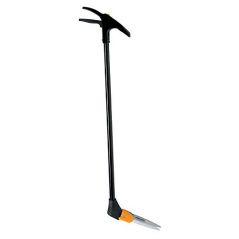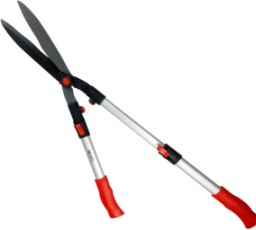Buying guide for best long-handle grass shears
Imagine if your stylist only used clippers and no scissors – that’s what it’s like to mow your lawn without trimming it after you’re done. Long-handle grass shears are the tool that adds style to your lawn. Grass shears neaten the areas where a mower can’t reach, providing a crisp, even look that is otherwise unobtainable.
When shopping for long-handle grass shears, you’ll want a durable, corrosion-resistant model that features a safety lock. You might also want to purchase shears with blades that swivel, which allows you to easily trim those hard-to-reach spots and clean up the edging.
If you are interested in learning about what to look for in a pair of long-handle grass shears, how to sharpen them, and how you can actually encourage your grass to grow by cutting it, keep reading. If you just stopped by to get a few recommendations on outstanding long-handle grass shears, consider the models that we’ve spotlighted on this page.
What are long-handle grass shears?
There are well over a dozen different types of gardening shears. Each has its own special purpose. However, the vast majority are for pruning. It is easy to recognize these types of shears as most have a crescent-shaped blade because they are designed to cut cylindrical objects such as stems and twigs.
Long-handle grass shears, on the other hand, resemble large scissors attached to the end of one or two long handles, depending on the type you purchase. The purpose of grass shears is to execute a uniform cut across several blades of grass at once. This allows you to give your lawn a precision trim that perfectly matches the areas that have been cut by a mower.
Admittedly, there are a few pruning shears that beginning gardeners may confuse with long-handle grass shears as they also resemble scissors with long handles. These models, however, feature excessively large and long blades. While they could be used to trim grass evenly in a pinch, they are designed for delivering a level cut to hedges.
Key considerations
Long-handle grass shears allow you to trim those hard-to-reach places that a lawn mower just can’t get to. There are three basic types: topping shears, edging shears, and multifunctional shears. The type of grass cutting you need to do determines which type of long-handle grass shears you should purchase.
Topping shears
When held, the blades of topping shears are horizontal to the ground. As you work the handles, they open and close, snipping above the grass. The lower you hold the shears, the more you remove from the grass. These types of grass shears are specifically designed to trim those awkward, hard-to-reach areas where a lawn mower just doesn’t fit, such as around a tree, between a wall and a fence, or under a deck.
Edging shears
When held, the blades of edging shears are vertical to the ground. As you work the handles, they open and close, snipping from the side. These types of grass shears are specifically designed to neaten up any edge you might have, whether it’s along a garden, path, or sidewalk.
Multifunctional shears
A multifunctional pair of long-handle grass shears allows you to accomplish both topping and edging with the same tool. This is possible because on these models the blades can rotate and lock in whichever position you desire. When you need to do some trimming, rotate the blades until they are horizontal to the ground. If you need to switch over to do some edging work, you simply reposition the blades, so they are vertical to the ground. This is a cost-effective way of getting two tools in one.
Did you know?
Even though summer can seem unending when it comes to lawn care, the average homeowner will only trim the grass roughly 20 times each year.
STAFF
BestReviews
Features
Operation
The most important feature to consider is whether you want long-handle grass shears that must be operated with both hands or shears that offer one-handed operation. Two-handed models have much less flexibility, but they are more powerful and built to last. One-handed models offer a wide range of features that are not available on two-handed models, but they are designed for lighter-duty tasks.
Materials
The handles on long-handle grass shears are typically made out of aluminum or steel. Steel isthe tougher material and is the material you should consider for heavier-duty use. Aluminum is lighter and the material of choice for people who are looking for a tool that is less fatiguing to use.
Swivel head
Multifunctional grass shears feature a swiveling head so you can either trim or edge your lawn and garden with the same tool.
Tilting head
If the long-handle grass shears that you purchase have a tilting head, you can change the angle of the blades in relation to the handles. This feature allows you to have a longer reach so you can trim underneath low structures. On some models, the blades fold back on the handles so the shears can be more safely stored or transported.
Wheels
Some long-handle grass shears feature wheels that allow you to trim grass more easily. These shears also produce a more level cut.
Comfortable non-slip grip
Whichever type of long-handle grass shears you purchase, you will be using your hands to operate them. The best models feature a comfortable, ergonomic, non-slip grip, so you can work harder and longer before tiring.
Safety lock
A safety lock is a must with long-handle grass shears. This keeps the shears from accidentally opening up when they are not in use.
Long-handle grass shears prices
Inexpensive: For less than $25, you can get a decent pair of long-handle grass shears that are lightweight, have swiveling blades, and feature one-handed cutting. These shears may be a little lacking in durability, but for many homeowners, they’re perfectly adequate.
Mid-range: Between $25 and $40, you can get a more durable pair of long-handled grass shears. At this price, you lose the swivel head and one-handed operation, but you get increased durability. The handles may be either aluminum or steel in this range.
Expensive: For over $50, you can get a heavy-duty pair of long-handled grass shears with handles that are made of steel. These durable tools may feature a 10-year warranty and could last a lifetime with proper care. Again, at this price point, there is no swivel or one-handed operation. If you want to trim and edge, you will need to purchase two different tools.
Tips
To get the best performance from your long-handle grass shears, you need to keep them sharp. For most homeowners, this is something that only needs to be done once each year. When sharpening your grass shears, keep these tips in mind.
- Clean your grass shears first. Before sharpening, make sure you remove all the dirt, grime, sap, and other substances that may have accumulated on your grass shears.
- Remove any rust. If there is rust on your grass shears, you can lightly sand it away, being careful not to sand the sharp edge of the blade. However, many individuals prefer soaking or spraying the blades in white vinegar and letting the shears sit overnight to loosen the rust. Afterwards, you can use a toothbrush or some steel wool to scrub away the rust. Then give the grass shears another quick rinse.
- Dry your grass shears. After thoroughly cleaning your grass shears, be sure to dry them off to help prevent rust.
- File the blade. Using a flat sharpening file, match the angle of the bevel on your blade and file the edge – if you do not match the bevel while sharpening, you may ruin the shears.
- Rinse again. To help remove any metal shavings, it’s a good idea to rinse the grass shears and dry them one final time.
FAQ
Q. How short can I safely cut my grass?
A. The deeper you cut a blade of grass, the more damage it does. Although grass is incredibly resilient – even if you trim away 90%, it will still likely grow back in under three weeks – most experts agree that the ideal is to only trim the uppermost third of the grass blade. This amount of trimming actually encourages the grass to grow and creates a density that can help prevent weeds from gaining a foothold in your yard.
Q. How often do I need to trim my yard?
A. It depends on the time of year. During the growing season, you should trim every week so that you are sticking with that rule of thumb to remove only a third of the grass with any single cut. As the growth rate decreases deeper into the summer, you will be able to back off on the frequency. If your lifestyle necessitates a routine – for instance, you can only trim every Saturday – you will still want to only remove a third of the blade with each trim.
Q. How does a dull blade ruin my grass?
A. The duller the blades are on your long-handle grass shears, the more you will rip the grass instead of cutting cleanly through it. Consider the difference between a surgical incision and catching your hand on a jagged nail. Torn grass takes on a brownish appearance along the top while the frayed edge invites infection.





















